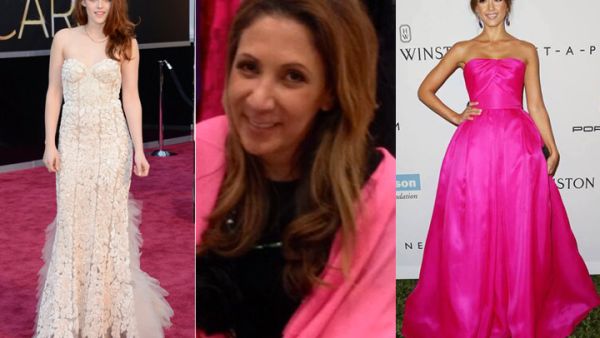Three decades after escaping Lebanon’s Civil War to fulfill her dream of making it in New York fashion, Reem Acra’s client list reads like a who’s who of Hollywood’s A-list.
Catherine Zeta-Jones, Angelina Jolie, Madonna, Halle Berry, Kate Hudson and Eva Longoria are just a few of the famous names who favor her luxuriously embellished eveningwear.
From the world of music, country singer LeAnn Rimes got married in one her creations – a low-cut chiffon robe slashed to the thigh and embroidered with pearls – while singer-songwriter Taylor Swift chose a strapless Reem Acra wedding gown for one of her videos.
Acra is proud of her achievements, explaining that is she is the only Middle Eastern woman to establish her own fashion house from scratch in New York.
Now, with success firmly under her belt, she is turning her attention back to the Middle East to help kick-start a homegrown fashion industry.
The designer is working on a plan for the region, although she stresses it is in its early stages.
“There is no [fashion] industry there today. But is there an eagerness for it? Absolutely,” she told AFP in an interview in Paris. “I am getting involved. ... There is an eagerness in these countries; they want to expand, they want to be part of the fashion scene.
Acra is far from the first international designer to return to her roots and push the industry in Lebanon, which has turned out some of today’s biggest names in the fashion world.
Paris-based ready-to-wear designer Rabih Kayrouz has been the country’s most vocal proponent of mentorship within the industry. He was a co-founder of the incubator Starch Foundation, which gives talented young designers a yearlong fellowship of seminars, business experience and exposure.
Elie Saab partnered with Lebanese American University to found its new fashion design major.
Indeed Lebanon has one of the highest ratios of designers per capita in the world. Name any red carpet event, and Lebanese dominate the best-dressed lists with familiar names such as Saab, Zuhair Murad, Georges Chakra, Georges Hobeika and, of course, Acra herself.
Regionally, Acra’s assessment of the industry is accurate. Fashion design is a fledgling industry in places like the Gulf and the Levant outside of Lebanon. Thanks to Dubai’s new push to be a world fashion capital, Acra is getting on board just as the region has taken an earnest interest in design.
“I will help it to develop. I think there will be opportunities to help designers develop and grow the industry,” she told AFP.
With 30 years’ fashion experience in the U.S. and Asia, Acra has plenty of insights to share.
The designer, who has four homes, two in New York, one in Lebanon and another in Nashville, got her first break while studying at the American University in Beirut.
There, she impressed a visiting fashion editor with an embroidered silk organza gown she made from her mother’s dining room tablecloth and wore to a party.
The editor offered to host a fashion show for Acra, and in 1983, she found herself in New York studying at the Fashion Institute of Technology.
“It was 100 percent difficult,” she said, adding that there had been no question in her mind that she would have to leave Lebanon, then in the grip of civil war, to make a career for herself.
“[But] I knew from the beginning that something would happen for me in New York in a good way.”
After stints in Hong Kong, Taiwan and China, she said she eventually felt she knew the U.S. fashion industry inside out and was ready to branch out on her own.
In 1997 she launched her own label, beginning with bridalwear. She later moved into evening dresses followed by ready-to-wear.
Acra’s clothes are now shown at New York Fashion Week and sold in over 150 stores worldwide.
In today’s global market, she says, her main challenge is now to design for all women, not just those from one or two countries.
“When I am designing I have to think about the woman in Saint Tropez, I have to think of the Chinese woman and I have to think of the Middle East all in one dress.”
Nor does she target women of any specific age, said the designer, whose personal favorite for eveningwear is vintage ivory and pale platinum:
“My woman is not of a particular age. I erase her age in my mind,” the designer said.
Her Middle East plan, meanwhile, is still on the drawing board, although she is confident it will yield results.
“I would say they are at the very beginning [in the Middle East] and fashion does not get established in two days, fashion takes time,” she said.
But she added: “There will be a Middle East fashion industry.”








